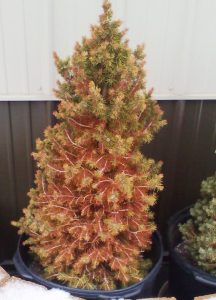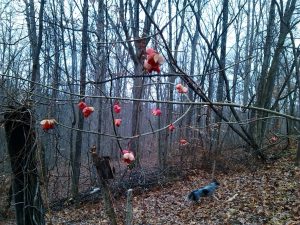Q. I am sending you some pictures of my shrubs that are in front of my business. This winter was very difficult on everyone and seems to have taken its toll on my shrubs. I think I know what your answer is going to be. But here goes!
The foliage that has turned brown/rust color is on the front of all four shrubs. The backs are not as bad, since they were against the building. I presume this is somewhat of a windburn. Is there any hope they will come out of it? Or is my best bet to replant or turn them around and face the green out? RS, Columbus, Ind.
A. Indeed, this winter was quite a challenge for many woody landscape plants and, in particular, the evergreens. Despite being fully dormant, the shrubs’ plant tissue was still subject to losing too much water – a condition called desiccation.
This year’s unusually heavy and consistent snow cover provided good insulation, and most plants went into this winter with a good moisture supply. However, when the ground is frozen solid and extreme low temperatures are accompanied by high winds, the plants continue to lose moisture without being able to replenish the supply.
Evergreens and, particularly, broadleaved evergreens such as rhododendron and holly are the most susceptible, because they have a greater surface area through which to lose water compared to deciduous plants. Deicing salts will further aggravate the situation. Severe desiccation will be obvious as brown needles and scorched leaves on broadleaved evergreens, as well as dead twigs and buds. Plants may further dieback as summer stress such as heat or drought applies additional pressure. In addition, your shrubs appear to be planted in plastic tubs rather than in the ground. The roots were more likely exposed to severe cold temperatures, which also compromises their ability to recover.
Unfortunately, the needles that have turned brown cannot be revived. Pine, spruce and fir cannot replace the dead needles on that part of the twig, so the result will be bare spots as the brown needles fall out. Some evergreen shrubs such as yews and arborvitae can be pruned back with some branch renewal filling in. If these specimens were planted in the ground, I would not recommend digging them up to rotate their position, as that would further damage the roots. But you could rotate the orientation of these containers to see if they look attractive enough to keep. Otherwise, you might think about replacing with different species that would be better suited to this confined available space.
Q. I had my side yard cleared of some brush last fall and came upon this small tree with pink “fruit.” Can you tell me what kind of tree or shrub it is? PG, Solsberry, Ind.
A. This is one of the shrubby Euonymus species. There are a couple of possible species, but I can’t distinguish enough character from this photo to be certain. It could be the native Euonymus atropurpureus, also known as Eastern Wahoo. However, I believe it is more likely Euonymus bungeanus, a species introduced from China and more commonly known as winterberry euonymus.

